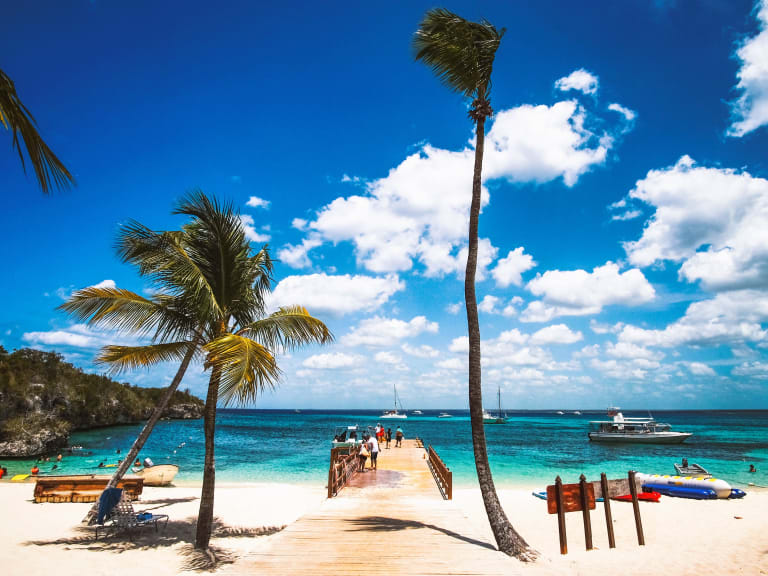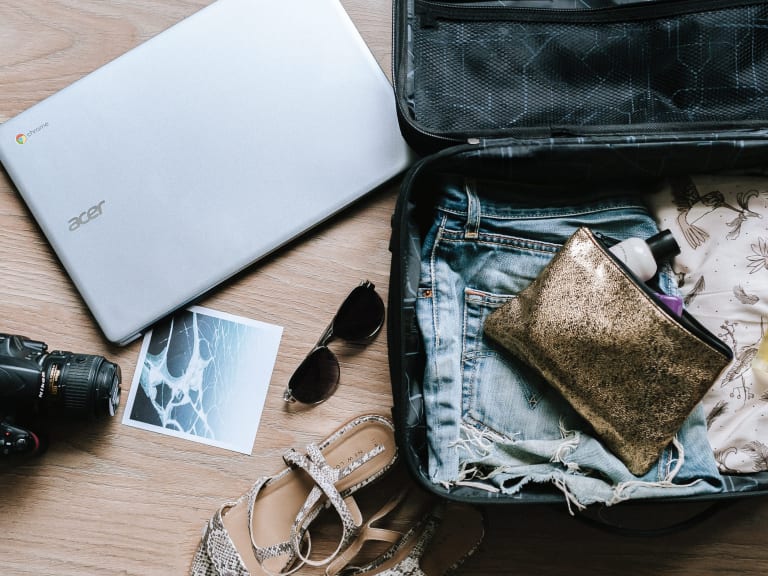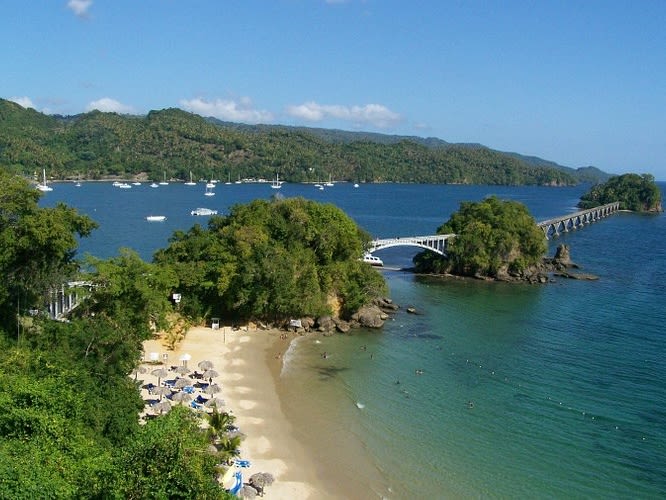More about: Day Trips to Santo Domingo from Punta Cana
Punta Cana is located at the confluence of the Caribbean Sea and the Atlantic. It is a privileged area with white sandy beaches, palm trees and nature reserves. Here you can enjoy numerous outdoor activities, explore the reefs or simply enjoy the nightlife.
There are many things to see and do in Punta Cana, but if you're staying for at least a week, I recommend a day trip to the capital. Read on and find out all you need to know.

Santo Domingo Day Trip from Punta Cana
Discover Santo Domingo, America's oldest city
Explore colonial history in the first city founded in America, with visits to iconic monuments, museums and streets full of cultural heritage.
If you're in Punta Cana and want to immerse yourself in the history of the Americas, I recommend this excursion to Santo Domingo. Accompanied by a local guide, you'll tour places like Calle Las Damas, the Alcazar de Diego Colon and the National Presidential Palace, discovering centuries of colonial history.
The tour includes round-trip transportation by air-conditioned bus, a guided tour of the city's main monuments and a stop to enjoy a traditional Dominican meal. In addition, you will have the opportunity to visit emblematic museums such as the Museum of the Royal Houses and the impressive Columbus Lighthouse.
Recommended if... You want to get to know the historical soul of the Dominican Republic in a complete and enriching excursion from Punta Cana.
How is the day trip to Santo Domingo?

This day trip to Santo Domingo from Punta Cana focuses on the Colonial Zone, the original core of the capital - this is a completely pedestrianised area with cafes, shops and restaurants.
The historic buildings of the capital are concentrated here: the Palacio Consistorial with its elegant clock tower, the Ozama Fortress, the ruins of the San Francisco Monastery and the houses of the Spanish colonists.
An air-conditioned vehicle will pick you up from your hotel in Punta Cana and accompany you to Santo Domingo. The group normally consists of a maximum of 49 travellers and includes an expert guide who will explain the history of the capital, with a major emphasis on the following attractions:
- Alcazar de Colon, the first fortified palace in the Americas. It is not dedicated to the more famous Christopher Columbus, but to his son Diego, who served as Viceroy of the Indies between 1511 and 1526.
- National Palace, the seat of government. It was designed by Italian architect Guido D'Alessandro and inaugurated in August 1947. This monumental building was commissioned by the former dictator of the Dominican Republic, Rafael Leónidas Trujillo.
- Museo de las Casas Reales, the cultural institution that traces the colonial history of the Caribbean country. It housed both the court and the governors' residence. Its various rooms illustrate, among other things, pirate attacks, the history of the sugar industry and paintings from the period.
- Catedral Primada de América, the oldest cathedral on the continent. It was built in the 16th century and is Gothic in style.
In the eastern part of the city, a few minutes from the Colonial Zone, is the Columbus Lighthouse, a colossal concrete structure that pays homage to the discoverer of the New World. The project was designed by two architects: J. L. Gleave and Teófilo Carbonell. It is vaguely reminiscent of a Mayan pyramid.
Interesting details
- Duration: between 10 and 12 hours
- Price: - from £69.
- What's included: hotel pick-up, transport to and from Punta Cana, local guide and traditional Dominican lunch.
Other option: Excursion to Santo Domingo with visit to Los Tres Ojos Lake

This route is practically the same as the simple visit to Santo Domingo, but includes the entrance to Los Tres Ojos National Park, which is located a few kilometres from the capital.
An air-conditioned bus will pick you up from your hotel in Punta Cana and take you to the Colonial Zone. The name of the first settlement was La Nueva Isabela, but a few years later it was renamed Santo Domingo.
An expert guide will lead you through this pedestrianised area with its picturesque corners and historic buildings, such as the Museo de las Casas Reales and the Alcázar de Colón. After leaving the city behind you, the bus will accompany you to Los Tres Ojos, a natural area characterised by three crystal clear cenotes:
- Lago de las Damas, in the past women and children used to bathe here.
- La Nevera, its waters are colder and darker.
- Lago Azufre, in the past it was believed that the white rocks were composed of this element
There is actually a fourth eye called Los Zaramagullones. It was discovered later, as it is surrounded by dense vegetation. These four lakes were created by a collapse of rocks thousands of years ago.
If you like nature, I recommend you read the post about day trips to Saona Island It is a postcard destination thanks to its white sandy beaches and palm trees that caress the sea. Sailing is done by catamaran and the transfer to the port is usually included.
Details of interest
- Duration: between 10 and 12 hours
- Price: more or less 100 €.
- What's included: hotel pick-up, transport to and from Punta Cana, local guide and guided tour of Los Tres Ojos.
What will I see on this type of excursion?

Santo Domingo is not only the capital of the Dominican Republic, but also the first seat of the Spanish Crown in the New World.
The old town preserves the traces of the island's colonial past, but that's not all. You'll also see more modern buildings such as the Columbus Lighthouse, a tribute to the Genoese navigator.
When is the best time to take a trip to Santo Domingo?

The Dominican Republic is a Caribbean country, so be aware of the rainy season. To enjoy pleasant temperatures and avoid hurricanes, it is advisable to travel to the island between December and April. Even so, temperatures are pleasant all year round and major storms are unlikely to reach Punta Cana.
If you want to travel to the Caribbean without spending too much, October and November are the best months. There are fewer tourists and hotel prices are more affordable. If you want to go deeper into this topic, I recommend you to read the post about the best time to go to Punta Cana.
Are there hurricanes in the Dominican Republic?
In the Central American country, the hurricane season roughly corresponds to the summer. Normally, August and September are the most affected months. However, there are a few factors to take into account:
- Hurricanes do not hit the Dominican Republic every year .
- Hotels are prepared for storms.
- Accommodation is much cheaper as it is in the low season.
- Lows don't usually drop below 24 degrees Celsius.
- Rainfall is short-lived (less than 10 minutes).
What are the advantages of taking a tour vs. visiting Santo Domingo on my own?

For carefree travel it is best to book a guided tour. You won't have to worry about traffic jams, you will have an expert guide at your disposal as well as some entrance fees to the attractions of the capital. All this without having to spend an excessive amount of money.
The roads in the Dominican Republic are in good condition (they are fairly new) and the trip from Punta Cana takes about 2.5 hours. However, driving is difficult due to heavy traffic and little respect for the rules of the road.
Can I go to Santo Domingo from Punta Cana on my own?
Yes, if you have booked a car at the airport, you can get to the capital via the Coral Highway and the Eastern Highway. The journey takes about 2.5 hours and there are tolls.
Street parking is free in Santo Domingo, but finding a parking space is difficult. In any case, I recommend leaving your car in a paid car park.
Alternatively, you can take a bus. The company Expreso Bávaro guarantees connections between the two locations. In Punta Cana, the vehicles leave from Cruze de Friusa and Cruze de Veron and a one-way trip (no return trip) costs about 400 Dominican pesos ( 7.5 €).
However, it is not possible to book in advance and if you want to secure your place, you should be at the station at least 1 hour before the bus leaves. It is not very convenient and this is why most tourists choose to hire an organised tour.
Is it advisable to take a trip to Santo Domingo with children?

Yes, as it is an organised excursion you won't have to walk too far and you will undoubtedly see some interesting sights. However, the excursions do not touch on the places that the little ones might like the most, such as Chinatown, the Trampolín Children's Museum or the Iberoamerica Park.
Do you think this activity would be too boring for them? No problem! Thanks to the good temperatures all year round, there is no shortage of options for outdoor activities with your kids. For more ideas I recommend you read the post about the best things to do in Punta Cana with kids.
What are the typical dishes of Santo Domingo?

Most excursions to Santo Domingo include lunch. At midday, your guide will take you to a local restaurant where you will have the opportunity to taste the typical dishes of the Dominican Republic:
- Mofongo, a side dish with African roots. It is a kind of puree made by mashing fried plantains, pork rinds and garlic. It is the perfect accompaniment to meat dishes
- Catibias, fried cassava patties stuffed with cheese or meat. In Santo Domingo, chef Anthony Bourdain highlighted the catibias at Mesón De Bari, in the Colonial Zone (Calle Hostos 302).
- Yaniqueques, the country's most popular street food. It is a crispy fried dish in the shape of a disc. There are sweet and savoury versions that can be found in every corner of the capital. According to locals, it was born as an imitation of the Johnny Cake, a pancake originally from Rhode Island, USA.
- Pasteles en hoja, the Dominican version of tamales. They are prepared with a plantain dough filled with meat and wrapped in a banana leaf. Traditionally, they are only found at Christmas.
- Sancocho, a hearty soup with root vegetables, pulses, rice, vegetables and meat. In case you are really hungry, I recommend you try the Sancocho 7 carnes with chicken, different cuts of pork, hen, beef, guinea fowl and goat. In the capital of the Dominican Republic, you can eat a more modern version at the restaurant Buche de Perico (Calle El Conde 53).
- Mangú, mashed green plantains with a garnish of red onions. This dish also comes from Africa, specifically the Congo.
- Bizcocho Dominicano, a spongy cake with a pineapple, vanilla and orange filling. If you want to take a piece back to your hotel, I recommend going to the Fresco del Horno pastry shop (Calle Lorenzo Despradel 20).
What typical souvenir can I buy on the excursion to Santo Domingo?

Looking for an original gift or souvenir? Here is a list of the most recommended options:
- Limé dolls, the symbol of the Dominican Republic. They are colourful dolls with faceless faces and represent the cultural mix of the country. In the capital you can buy them in the Mercado Modelo (Avenida Mella) and in other gift shops in the Colonial Zone.
- Coffee, one of the most exported products. It is grown in the northeast of the island and is characterised by its acidic and aromatic flavour. You can find good blends at Casa Barista (Calle Victor Garrido Puello).
- Amber and Larimar, two precious stones extracted from the Dominican Republic's subsoil. You can find them in the shops in Calle El Conde.
- Rum, another typical product of the island. The most famous brands are Brugal (founded by a Spaniard who settled in Puerto Plata), Bermúdez (the oldest) and Barceló. If you want to have a good drink before you decide, I recommend you book a table at Sugar Cane - La casa del ron ( Calle Arzobispo Meriño 204).
- Chocolate, a crop that has been grown in the country since the 16th century. In Santo Domingo, you can buy bars and treats at Kahkow (Calle Las Damas 102). They also organise guided tours of their farm.
What do I need to bring for an excursion to Santo Domingo?

It depends on what you want to do. In any case, the Dominican Republic is a tropical country and the humidity is very high. I recommend you to bring breathable clothes to alleviate the heat sensation. If you are travelling during the rainy season , a mackintosh is essential.
Of course, a swimming costume is a must, as are flip-flops and a hat to protect you from the sun. If you're planning on doing strenuous activities, such as a zip-line experience in Punta Cana, you'll want to pack comfortable sportswear and closed-toe shoes.
In general, I recommend bringing (or buying locally) a good insect repellent. Unfortunately, mosquitoes are a constant presence near the pools although if you travel in the dry season, their numbers will be lower.
If you enjoyed our excursion to Santo Domingo, you may also be interested in

The Caribbean country is not only beaches and sea. The green interior is marvellous and also has charming cities. Here are the best ones:
- Altos de Chavón, the replica of a 16th century Mediterranean village. Despite its ancient appearance, it was completed in the 1980s! Its landmarks are the Church of San Estanislao, the archaeological museum and the amphitheatre which was inaugurated with a performance by Frank Sinatra. If you like golf, I recommend you check out the impressive Dye Fore green.
- Puerto Plata, the country's first commercial port. It was founded in the 19th century and its old town is a mixture of Victorian and neoclassical buildings. Its landmark is the 16th century Fortaleza de San Felipe. Within walking distance of the town are two popular nature parks: Ocean World and a capuchin monkey sanctuary. If you are interested in the latter, I recommend you read the post about excursions to Monkeyland from Punta Cana.
- Santa Bárbara de Samaná, a town known for its quaint little colourful houses. It is located in a splendid bay and houses an interesting museum dedicated to humpback whales. It's open Monday to Friday from 8:30am to 3pm and admission costs about €3 (at the exchange rate). Also worth seeing is La Churcha, a church built by freed slaves.
- Barahona, the city of carnival. It is located in the western part of the country, more than 5 hours drive from Punta Cana. However, it is worth the drive to get into the Villa Miriam spa which is made up of natural pools formed by a river.
- Santiago de los Caballeros, the second largest city in the country. Nearby, tobacco is grown and so a must-see is La Aurora Cigar World, a tobacco company that organises guided tours - you'll learn all about cigars! Another emblematic point is the Monument to the Heroes of the Restoration, recognisable by its large white tower that reaches 70 metres in height.
- Concepción de La Vega, a town founded by Christopher Columbus. It was destroyed by an earthquake, but you can still see the ruins of the Vega Vieja which include the old Fort Concepción.












